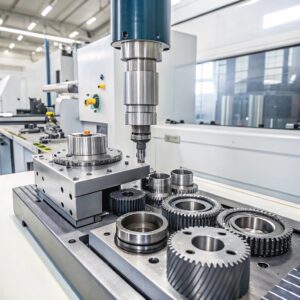Rotary encoders help measure position and movement in machines. Absolute rotary encoders give each shaft position a unique value. This keeps accurate data even if power is lost. Incremental rotary encoders measure position changes, making them cheaper and simpler. Robots and airplanes often use absolute encoders for accuracy. Incremental encoders are used when exact position data isn't needed. New technology is improving both types for tough conditions.
Key Takeaways
-
Absolute rotary encoders give a unique value for each spot. They keep track even if power is lost.
-
Incremental rotary encoders are cheaper and easier to use. They work well when exact position isn't needed.
-
Use absolute encoders for precise jobs like robots or airplanes. Incremental encoders are better for simple, speed-based tasks.
-
Think about the environment and job needs before picking an encoder. This helps it work its best.
-
Always read the maker's details to check features and fit. Make sure the encoder works with your system.
Incremental rotary encoders
How they work
Creating pulses and tracking position
Incremental rotary encoders turn motion into electronic signals. A spinning disc has clear and dark sections. A light shines through the clear parts and is blocked by the dark ones. A sensor reads these changes and makes pulses. These pulses show how the encoder's shaft moves and tracks its position.
The encoder makes a set number of pulses each spin. This number decides how detailed the measurements are. For instance, an encoder with 5,000 pulses per spin can measure tiny movements. This makes it great for tasks needing exact speed and distance tracking.
Using two signals to find direction
Incremental encoders have two output channels, A and B. These channels send square wave signals that are slightly offset. By checking the order of these signals, you can tell if the shaft spins clockwise or counterclockwise. This is important for things like motor control, where knowing the direction matters.
Benefits
Affordable and simple
Incremental encoders are cheap and easy to use. They work well when you only need to measure changes in position. Industries like elevators, conveyor belts, and CNC machines often use them. They are reliable without needing complex absolute position tracking.
High detail for speed and distance
These encoders give very detailed measurements for speed and distance. They use fewer parts and are simple in design. This keeps costs low while still working well. Some models can handle extreme temperatures, like -40°F to 212°F, and still give high detail.
Drawbacks
Loses position after power cuts
A big problem with incremental encoders is losing position data when power goes out. When power returns, the encoder needs to reset to a starting point. This can slow things down, especially if power cuts happen often.
Needs a starting point to track position
Incremental encoders can’t show exact positions without a starting point. You must set this point during setup or after power loss. This makes them less useful for jobs needing constant position tracking.
Applications
Industrial automation and motor control
Incremental encoders are important in factories and motor systems. They help check motor speed and position accurately. These encoders send signals that show how fast something spins. This helps machines work smoothly and stay under control.
For example, conveyor belts use these encoders to keep steady speeds. The number of pulses per spin (PPR) shows how detailed the measurements are. High PPR encoders are great for tasks needing fine speed changes. But, they lose position data if the power goes out. To restart, you must reset them to a known position.
Robotics and CNC machinery
Robots and CNC machines need incremental encoders for exact movement control. Robots use them to track joint positions and move correctly. CNC machines use them to guide tools along precise paths.
These encoders can also tell which way something spins. They use two signals to check if it turns clockwise or counterclockwise. This is helpful for tasks like moving robotic arms or milling machines.
Incremental encoders are good for jobs needing low cost and simple design. Even though they lose position data after power cuts, their high detail and quick feedback make them dependable for many machines and robots.
Absolute rotary encoders
How they work
Unique values for each position
Absolute rotary encoders give every shaft position its own value. A disc with rings has light and dark patterns. Sensors read these patterns and turn them into digital codes. These codes show the exact shaft position. Unlike incremental encoders, they don’t need a starting point. They keep tracking even if the power goes out.
For example, a machine dividing a 25-inch leadscrew into 0.001-inch steps needs high precision. An absolute encoder with 25,000 points can handle this. Its high resolution makes it perfect for precise tasks.
Using binary or Gray code
Absolute encoders use binary or Gray code to show positions. Gray code is better for fast-moving parts. It changes only one bit at a time, lowering errors. It works well with different communication systems.
Binary code is simpler but can cause more mistakes during changes. The choice depends on how fast and accurate the system needs to be.
Benefits
Keeps position after power loss
Absolute encoders save position data even if power is lost. Each position has a unique code, so no reset is needed. This is important for systems like robots or airplanes that must keep running.
| Feature | Benefit |
|---|---|
| Position Memory | Keeps exact position data after power loss for smooth operation. |
| High Precision | Gives accurate feedback, great for robotics and measuring tools. |
Very accurate and dependable
Absolute encoders are highly accurate and reliable. Their resolution depends on the number of bits, like 12 bits giving 4,096 positions per spin. This detail is great for tasks needing exact control, like medical tools or factory machines.
Drawbacks
Costs more than incremental encoders
Absolute encoders are pricier because they have advanced parts. They don’t need resets, which makes them worth it for critical jobs. Over time, they can save money by needing less maintenance.
More complicated to design and use
Absolute encoders have a complex design with extra parts like sensors. Adding them to systems can take more effort, especially for very accurate tasks. Even with these challenges, their benefits make them essential for precise work.
Absolute encoders are best for jobs needing accuracy and reliability. They cost more and are harder to set up, but their performance is worth it for important systems.
Applications
Aerospace and defense systems
Absolute rotary encoders are important in aerospace and defense work. They are used in navigation systems to give exact position data. This helps control movement accurately and keeps things stable. Flight control systems also depend on them for safe and steady operation.
In defense, these encoders are needed for precise and reliable tasks. For example, they improve targeting systems and guided vehicles' accuracy. Since they keep position data after power loss, they are crucial in emergencies. Safety is never compromised with these encoders.
Some common uses of absolute encoders in aerospace and defense include:
-
Giving accurate positions in navigation systems.
-
Keeping flight control systems stable.
-
Improving targeting systems for better safety.
Medical equipment and robotics
In healthcare, absolute rotary encoders help with precision and reliability. They are used to adjust hospital scissor beds automatically. This makes it easy to change their height as needed. They also help position stabilizers for large medical machines, ensuring smooth operation.
Robots in healthcare also benefit from these encoders. They allow robotic arms to do delicate tasks, like surgeries, with great accuracy. Even after a power outage, these encoders keep robots working smoothly. This reduces delays and keeps everything efficient.
Key uses in medical equipment and robotics include:
-
Positioning stabilizers for medical machines.
-
Helping robots move smoothly after power outages.
Absolute rotary encoders are dependable and precise for aerospace, defense, and healthcare. Their ability to save position data makes them perfect for these critical fields.
Absolute vs incremental rotary encoders: A comparison
Image Source: pexels
Functional differences
Absolute encoders give exact positions; incremental encoders track changes.
Absolute rotary encoders show exact positions by giving each spot a unique value. This means they keep position data even if power is lost. For example, they use binary or Gray code to show angles, making them great for jobs where downtime is costly.
On the other hand, incremental encoders track movement changes, not exact positions. They create pulses as the shaft moves and need a starting point to find the exact position. If power goes out, they lose their data and must reset, which can be a problem for important systems.
Performance comparison
Accuracy, reliability, and detail
Absolute encoders are very accurate and dependable. They give exact position data right after power is restored, so no reset is needed. This makes them perfect for precise work like robotics and airplanes. Their detail depends on the number of bits, with more bits giving better precision.
Incremental encoders are simpler but less accurate than absolute ones. They count pulses to track movement, which can cause mistakes if pulses are missed. Still, they work well for tasks needing quick speed and direction checks.
Cost and design
Incremental encoders cost less and are easier to set up. Their simple design lowers starting costs, making them good for tight budgets. But, they depend on other systems to track positions, which can raise maintenance costs later.
Absolute encoders cost more but save money over time by reducing downtime and repairs. Their advanced design and ability to keep position data make them worth the higher price for critical tasks.
Application suitability
When to pick absolute encoders
Absolute encoders are best for jobs needing high accuracy and no interruptions. They work well for CNC machines, vehicle stabilizers, and robots that must restart smoothly after power loss.
When to pick incremental encoders
Incremental encoders are great for tasks focused on speed and direction. They are often used in motors, conveyor belts, and other jobs where low cost and simplicity matter. But, they are not ideal for places with frequent power outages.
Choosing the right rotary encoder
Key factors to consider
Application needs (e.g., accuracy, speed, cost)
When picking a rotary encoder, think about your system's needs. The resolution you need depends on how precise your system must be. Faster systems work better with high-resolution encoders. These detect small changes quickly. For example, optical encoders are often more accurate than magnetic ones. This is especially true when signal errors could cause problems.
Accuracy is also very important. It is measured in degrees or smaller units like arcminutes. Absolute optical encoders can be accurate to 0.18 degrees (10.8 arcminutes). Some models go up to 0.25 degrees. However, accuracy depends on the brand and how you use the encoder. Always match the encoder's precision to your system's needs.
Environmental conditions (e.g., temperature, vibration)
The place where the encoder works affects how well it performs. Extreme heat, cold, or shaking can shorten its life. Some encoders can handle temperatures from -40°F to 212°F. These are good for tough industrial jobs. If your system shakes a lot, pick an encoder with a strong design. This will help it last longer.
Practical tips
Check manufacturer details
Always read the manufacturer's guide before buying an encoder. These guides explain how the encoder works and what systems it fits. They also show features like communication options and durability. Knowing these details helps you choose the right encoder for your system.
Think about long-term use and care
Look beyond the price and think about how reliable the encoder is. Many modern encoders have high resolution and better precision. These features improve how well they work in motion systems. Strongly built encoders need less fixing, saving time and money. Pick one that balances cost, durability, and performance for the best value.
🛠️ Tip: Choose an encoder that fits your needs now and can handle future upgrades or changes.
Absolute and incremental rotary encoders are used for different jobs. Absolute encoders are great for tasks needing exact positions, like robotic surgery or CNC machines. They keep position data even if power goes out, making them reliable for important systems. Incremental encoders are cheaper and work well for simpler tasks, like controlling motors or running conveyor belts.
Absolute encoders allow precise movements without extra parts, making them perfect for tasks like moving robots.
| Feature | Absolute Encoder | Incremental Encoder |
|---|---|---|
| Provides Absolute Position | Yes | No |
| Cost for Manufacturers | Higher | Lower |
| Safety Applications | Yes | No |
Pick the right encoder based on your budget, accuracy needs, and if keeping position data is important.
FAQ
What is the main difference between absolute and incremental rotary encoders?
Absolute encoders give each position a unique value. Incremental encoders track movement changes and need a starting point to find exact positions.
What happens to position data if power is lost?
Absolute encoders keep position data even if power goes out. Incremental encoders lose all data and must reset to a starting point after power returns.
What type of encoder should you choose for high-speed applications?
Incremental encoders are best for high-speed tasks. They give quick feedback and detailed measurements, making them great for motors and conveyor belts.
What makes absolute encoders more expensive?
Absolute encoders have advanced parts and a complex design. These features let them save position data during power loss, which raises their cost.
What industries commonly use rotary encoders?
Rotary encoders are used in robotics, aerospace, healthcare, and factories. Absolute encoders are chosen for precise jobs, while incremental ones are used for simpler, cheaper tasks.






